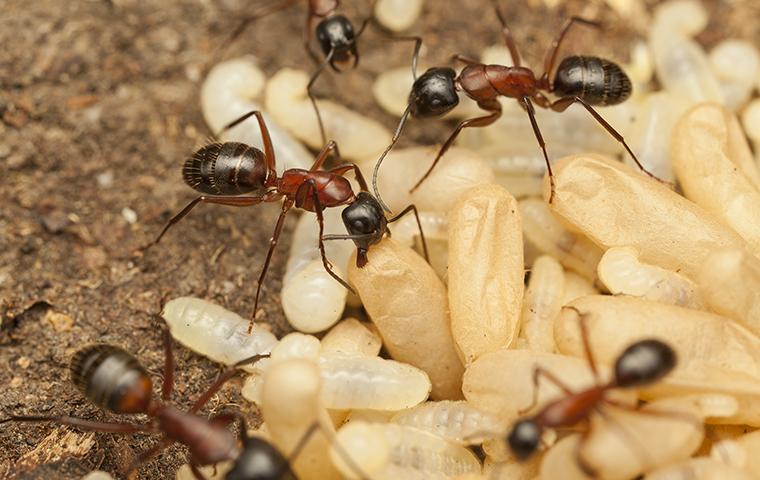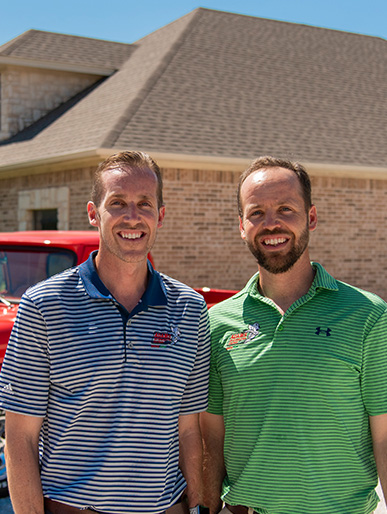
Carpenter Ants

Brief Overview of Carpenter Ants
Carpenter ants use their extremely strong mandibles to hollow out channels in wood to build their nesting areas. When found outdoors, carpenter ants are not a serious threat to your property. However, once a colony finds its way inside, you want to consider carpenter ant treatment and extermination as these ants can cause significant and costly damages. Unlike termites, they will not eat wood. However, as their nests and colony grows over time, they will weaken the structural integrity of your home. Furthermore, the existence of carpenter ants may be an indicator of rot or moisture which can lead to significant structural damage over time.
What Do Carpenter Ants Look Like?
Carpenter ants are commonly black in color but may also be red, yellowish, or a combination of colors. They are large ants. Adult workers may grow up to ½ of an inch in length and queens can reach up to one inch in length.
Carpenter ants have oval-shaped, segmented bodies, six legs, and antennae that is elbowed (unlike termites that have straight antennae). Workers have large, strong mandibles that help them to excavate in wood. These mandibles are also strong enough to cause a painful pinch.
Do carpenter ants have wings? The answer is: some do, and some don’t. Worker ants do not have wings whereas mature, reproductive members of carpenter ant colonies are winged ants. Carpenter ants with wings resemble termites, and often these two pests will swarm together. If you detect a carpenter ant infestation, it’s important to properly identify the pest, as termite treatment differs drastically from carpenter ant extermination.
Where Do Carpenter Ants Nest?
Outside, carpenter ants nest inside trees and prefer damp, rotting, or dead wood. Inside homes and structures, it is common to find foraging carpenters in the kitchen, but they may also create satellite nests in wall voids, under floors, in crawl spaces, in wood framing doors and windows, and in other areas where there is water-damaged or rotting wood.
What Do Carpenter Ants Eat?
You might think that carpenter ants eat wood, but they don’t. They just tunnel through it to create nests. Rather, carpenter ants consume other insects and honeydew (a sweet liquid that is left behind by aphids and scale insects) in their natural environment. Inside homes, they’ll head for the protein and sugar including meat, pet food, syrup, and honey.
Are Carpenter Ants Dangerous?
When it comes to carpenter ants, the health threat is zero. These ants can bite, but they rarely do so, and they do not spread disease. Carpenter ants are definitely an annoyance when they invade kitchens and pantries and infest food. Plus, seeing a line of ants marching across the floor or carpenter ants with wings attack crumbs on your counter would make anybody feel uneasy.
Though they may not be a threat to your health, the real threat these large ants pose is one to the structural integrity of dwellings and buildings. Carpenter ants are wood-destroying insects, and their tunneling habits will cause damage to support beams, flooring, and other building materials. Left untreated, an infestation of these ants could result in significant damage and costly repairs.
What Is the Difference Between Carpenter Ants and Termites?
It's common to mistake carpenter ants for termites or vice-versa. They’re both wood-destroying insects with winged reproductive members of their colonies that swarm. However, in spite of their similarities in appearance, they are different pests and require completely separate treatment methods. It’s important to recognize notable differences between the two species to help identify and treat an infestation.
- While winged reproductive members swarm from both termites and carpenter ant colonies, termite swarms are very large, numbering in the thousands. Carpenter ant swarms, on the other hand, are usually smaller.
- Termites actually feed on wood while carpenter ants only create tunnels in wood. If you have a carpenter ant infestation, you are likely to find shavings, also known as frass, on the floor below an exit point. Termites do not leave behind shavings. Termite workers are rarely seen out in the open while it’s common to find carpenter ants searching for food sources.
- Termites create mud tubes on the outside of walls or underneath the surface of the soil that they use to travel back and forth between their nest and food source. Carpenter ants do not create mud tubes.
- Carpenter ants look like large black ants; termites look like small, whitish, soft-bodied “ants”.
- Carpenter ant tunnels and galleries are smooth and “neat” looking; termite tunnels and galleries are uneven and very “messy” looking.
- Reproductive carpenter ants with wings are pinched between their thorax and abdomen whereas winged termites do not have a narrow center point.
- Flying carpenter ants have two pairs of wings; The front pair is longer than the rear pair. In contrast, winged termites have wings of equal lengths.
Why Do I Suddenly Have Carpenter Ants?
If you’re suddenly facing a carpenter ant problem, you’re not alone. These pests can appear seemingly out of nowhere, and understanding why can help you address the issue effectively. Here are the primary reasons why carpenter ants might suddenly invade your home:
- Moisture Issues: Carpenter ants are particularly attracted to moisture. Leaks in your plumbing, roof, or areas with high humidity can create an ideal environment for them. Moisture weakens wood, making it more accessible for ants to chew through and establish nests.
- Wood Damage: Carpenter ants prefer to nest in wood that’s already damaged or decaying. If you have old, untreated wood or structural damage from previous infestations or neglect, it can attract these ants. They don’t eat the wood but hollow it out to create their nests.
- Food Sources: Carpenter ants are also drawn to food. If you have crumbs, spills, or improperly stored food, it can attract them indoors. They are particularly fond of sugary substances and proteins, which can be found in various household items.
- Existing Nests: Carpenter ants often establish nests outside but will search for new nesting sites if their current ones become overcrowded or if the environment becomes unsuitable. If an outdoor colony becomes too large or disturbed, ants may invade your home in search of a new, safer location.
- Seasonal Changes: Carpenter ants are more active during warmer months and may enter homes seeking food and shelter as temperatures rise.
To effectively manage a carpenter ant infestation, it’s crucial to address these underlying factors. Our team at Adams Pest can conduct a thorough inspection, identify the source of the problem, and implement targeted treatments to eliminate the infestation and prevent future issues. Contact us today to restore peace and comfort to your home.
How Do I Get Rid of Carpenter Ants?
To eliminate carpenter ants from your property, professional remediation is necessary. The professionals at Adams Exterminating Company provide carpenter ant control in Lewisville, Denton, and communities throughout Northern Texas and the greater Dallas-Fort Worth Metroplex. Extermination begins with a thorough inspection of the property to develop a treatment plan that will eradicate these ants. To learn more about our effective carpenter ant control services, please contact us.
Helpful Carpenter Ant Articles
- Signs Your Home Is Infested With Carpenter Ants
- What Does Carpenter Ant Damage In Lewisville Homes Look Like?
- Why Call A Professional About Carpenter Ant Damage
- Preventing Carpenter Ants From Damaging Your Lewisville Home
- The Ants That Call North Texas Home
- How Lewisville Residents Can Keep Their Home Ant-Free Year-Round
- Why Ants Enter Frisco Homes & How To Keep Them Out


